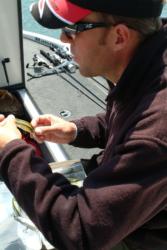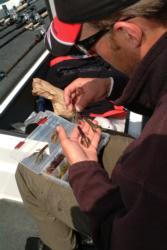Martens’ mania
Martens: Littlest things make biggest differences in professional bass fishing

ROGERS, Ark. – The sport of bass fishing is chock full of tiny differences in everything from weight sizes to lure colors, to the point that minutiae can be maddening.
For instance, can a bass really tell the difference between a “green pumpkin” worm and a “watermelon seed” worm?
How can a bass possibly tell if you are using a 7-foot rod versus a 6-foot, 9-inch rod?
And what about line size? Is 8-pound-test really that much different from 10-pound-test?
Can miniscule variances in things like lure color, line size, weight size or rod action make that much of a different given all of the larger variables in bass fishing?
According to FLW Tour pro Aaron Martens, the littlest things make the biggest differences in professional bass fishing, and to say the least, Martens is obsessed with attention to detail in his perpetual search for the tiniest alternatives to traditional bass-fishing methods.
Considering that Martens has won over a million dollars between the FLW and BASS tours in the last eight years and was recently crowned the 2005 BASS Angler of the Year makes discounting his meticulous mania down to trivial pursuits a little more difficult.
This week, the California fishing savant has been on Beaver Lake near Rogers, Ark., practicing for the FLW Tour’s Wal-Mart Open, hoping to find the details that will help him win $200,000.
Difference is in the details
Martens’ acute attention to detail is a product of his fishing experience in the West, where bass are as picky as an IRS auditor.
“Out West you can’t just fling out a gnarly looking jig on 20-pound line and expect to get a bite,” Martens said. “Everything has to be perfect before you even have a chance of getting a bite.
“Over the years, I’ve learned that edges exist in every detail of fishing, and those edges add up in a major way. I want each detail – lure size, lure color, scent, line size, rod action – to all build into my favor instead of take away from it.”
But the attention Martens gives to every detail is almost frightening. For instance, consider his fanatical approach to colors.
 To Martens, the differences between similar-looking colors like green pumpkin and watermelon seed are as drastic as the differences between crankbaits and topwaters. In fact, Martens sees color differences within soft plastics of the same color, and it is not beyond him to sort out a bag of watermelon red finesse worms into two different piles: “really red” and “kind of red.”
To Martens, the differences between similar-looking colors like green pumpkin and watermelon seed are as drastic as the differences between crankbaits and topwaters. In fact, Martens sees color differences within soft plastics of the same color, and it is not beyond him to sort out a bag of watermelon red finesse worms into two different piles: “really red” and “kind of red.”
“The color, size and amount of flake in soft plastics vary, and it causes subtle changes in the colors of the bait, especially under the water,” Martens said, chuckling at his own fastidiousness.
“Color is one of those triggering mechanisms that can make a neutral fish bite,” he explained. “My biggest considerations for lure colors are water color and sky color (sunlight penetration).”
Since water color and sky conditions can change constantly, Martens is always experimenting with lure colors during a day of fishing, and his practice at Beaver Lake has been no exception. Several times a day Martens has been dunking new colors in the water to see what they look like.
“There are no hard, fast rules for color,” he added. “That’s what makes it fun. I can’t tell you if a color is right or not until I actually see it in the water. Lures, especially soft plastics, look completely different in the water than they do out of the water.”
Martens’ obsessive considerations do not stop at lure colors, though.
This week he has also been practicing with unconventional 5- and 7-pound-test Japanese-produced fluorocarbon fishing lines.
So what’s wrong with the traditional 6- and 8-pound-test lines?
“Something in between might be a little better,” he responded.
And why a 6-foot, 9-inch rod over a traditional 7-foot rod?
“If I’m working a fluke, that extra 3 inches of tip on a 7-footer takes up too much line on the twitches,” he explained. “The guy that fished through here before me may have been using a 7-footer and worked his Fluke too fast, pulling it too far on each twitch. This rod gives the bait a little different action, and that could be one of those edges I’m looking for.”
Aaron’s alternative angling approaches
When Aaron Martens first came onto the fishing scene in the late 1990s, he turned some heads with the drop-shot technique.
In March 2001, he put on a drop-shotting clinic at a Lake Martin FLW Tour event in Alabama by finishing third with the deepwater technique. In March 2002, he finished second at a Lake Wheeler FLW Tour event, once again, by drop-shotting.
He was soon labeled as a drop-shot specialist, but in time he proved that his strength was not just in one technique, but rather, in an overall unconventional approach to bass fishing.
 At the 2002 Bassmaster Classic on Lay Lake, Martens finished second by throwing a striper jig to sporadic schooling bass.
At the 2002 Bassmaster Classic on Lay Lake, Martens finished second by throwing a striper jig to sporadic schooling bass.
“They would surface for just a few seconds and then go down,” he recounted. “I needed a `fast’ bait, something that would cast fast and sink fast before the fish went down.”
In 2003, he won the Forrest Wood Open on Wheeler Lake by fishing Senkos in 5 to 8 feet of water on an obscure main-river point, while other finalists pounded the well-known Decatur Flats.
Then at the 2004 Bassmaster Classic on Lake Wylie, Martens again broke away from traditional bass-fishing wisdom and resorted to a “horsey head” type of spinner slow-rolled on bridge pilings to finish second.
One thing is for sure, no one can accuse Martens of following the crowds to find fish or techniques. Martens’ own mania has led him to these alternative approaches – something in which he takes pride.
“That’s where the reward is for me in this sport,” he said. “That’s what makes this fun – using my own creativity to figure out how to catch fish. When all of the little edges in all of those little details add up and I’m catching fish in a way no one else can duplicate – that’s when I’m at my best.”
But finding an alternative approach on Beaver Lake has proven frustrating for Martens this week. Due to the unusually warm weather, fish have started to move onto beds, possibly making for another sight-fishing shootout in the Ozarks.
Instead of looking for beds, Martens has been spending his practice days fishing water he has never fished before with a variety of techniques in search of something different.
“Every year the fish use the same places on this lake,” he said. “I have covered a lot of new water during practice trying to locate some areas that may have been overlooked, but nothing is happening. My next plan is to go to where the fish are and try to find a different way to catch them. But that’s going to be hard to do if they’re all on beds.”
Maybe a horsey-head spinner on bridge pilings?
“I might try that before this thing is over,” he laughed.